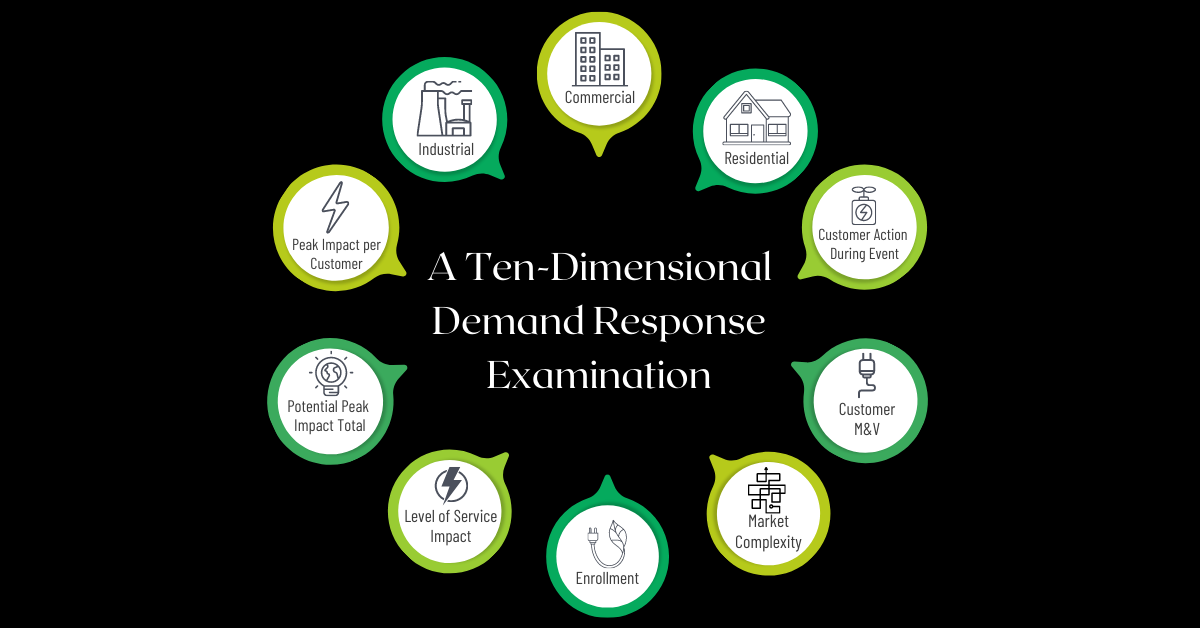
This is the third installment of this series in demand response (DR) and load management. In the first post, Curing Net Zero described why net zero is not the answer: everyone over-generates with solar or wind simultaneously, and later, everyone needs power from something else simultaneously. The second post, Demand Response Primer, gave an overview of families and specific types of load management. This time we’re looking at my scorecard of these DR resources.
Here is my report card, including critical factors for each DR resource, followed by discussions of what it means.
 What does this poppycock mean, Jeff?
What does this poppycock mean, Jeff?
Peak Impact Per Customer is the percentage of the total customer load that can be curtailed or replaced with a distributed energy resource like a natural gas generator, diesel generator, or battery. It is high for interruptible in which customers may curtail 50% or more of their load. It is low per customer for smart thermostats because temperature setpoints may be nudged only a degree or two – but there is power in scale for thermostats.
The potential peak impact total equals the load per customer for a given DR strategy times the number of participating customers. As we saw last week, interruptible for manufacturing is the dominant total DR resource. The rest are a matter of potential to build out those resources in the future. I gave water heaters a lower score because there aren’t many electric water heaters in some regions of the country.
Level of service impact refers to the disruption of business, hassle, uncomfortable conditions, and so on. Interruptions are bad in most cases when customers need to shut down manufacturing lines or go home for the day entirely. I’ll save permanent load reduction for later. As discussed last week, rate design, time of use (TOU), or demand rates are a hassle for customers (I’m not talking about auto-DR – set it and forget it – a separate category). This is what I call living your life around the utility bill. Only the super nerds like me are willing to do that IF the incentive is sufficient – and Xcel Energy’s TOU rates where I live are not close to being enough to trigger my behavior.
Enrollment refers to the ease with which customers may join a program with some consideration of benefits. For example, interruptible DR is quite easy. When there is a day ahead call for an event, plan to turn something off or use the generator tomorrow. Somebody just needs to identify the resources and the probable load reduction.
Thermostats are super easy to enroll in, as they may ask via the app or on the thermostat itself. The customer clicks “join.” Boom! Direct load control doesn’t require the customer to be around home or business as the work is done outside. Water heaters, however, require some coordination to get inside and maybe an internet connection which can always be fun.
Lastly, there are permanent load reduction, grid-interactive buildings, and auto-DR (for commercial and industrial, in this case). Those require significant engineering and maybe significant capital for permanent peak load reduction. I gave grid-interactive buildings the only F for a couple of reasons. First, there is no financial mechanism to make it worthwhile, and developing that won’t be easy, so it should be based only on real-time wholesale electricity prices. However, the intent is to be dispatchable from the grid operator. Good luck with that. A distributed energy resource management system (DERMS) is needed to translate and communicate with building resources and the grid – incredibly complex. DERMS are one thing for thermostats and battery chargers, but for minute-by-minute interface and control of building automation systems, it makes my head explode.
Market complexity indicates how easy/hard it is to measure and monetize the resource. Per the previous paragraph, grid-interactive buildings are the hardest to monitor and monetize, which is why I say, wholesale prices drive action, but then, it’s not dispatchable for the grid operators. Peak time rebate is a voluntary program where customers volunteer to curtail load in exchange for incentives. Measurement and verification (M&V) algorithms must be deployed for thousands of participants. To me, that’s hard, but it may be fun or even easy for someone else.
Customer M&V indicates whether savings at the customer level must be or may be verified. Everything between interruptible and peak time rebate is an aggregation of savings, and no one is evaluating site-level savings – it’s like prescriptive efficiency measures where we’re looking at bulk or average impacts.
Interruptible customers may have their load reduction verified on a site-by-site basis. As noted above, the peak-time rebates are measured site by site, by the thousands, with computer algorithms using the advanced metering infrastructure.
The last three columns indicate customer sectors in which DR resource lives. In most cases, one sector has the preponderance of the load control resources. Some DR resources don’t apply to certain sectors at all. For example, if a key account manager asks their corn processing plant to enroll in the smart thermostat program, they may lose the account. Hit the road, Jack, and don’t chu come back, no more, no more, no more, no more.
Rate design and permanent peak load reduction can apply to any customer type.
Wrap
As grid operators are scrapping for resources because of excessive thermal power plant retirements, the need for demand response and load management will skyrocket. How will the grid operators and utilities react? Grid operators are responsible for ensuring adequate resources. Utilities are responsible for keeping a reasonable lid on prices. Retailers in deregulated markets can find themselves in bankruptcy after one event (Texas) if they don’t hedge to protect themselves. Load management is an excellent answer to each case.
It’s a beautiful balancing act of cost-effectiveness, customer experience, and satisfaction. On that note, next week, I will wrap up DR for this year, focusing on permanent load reduction.




